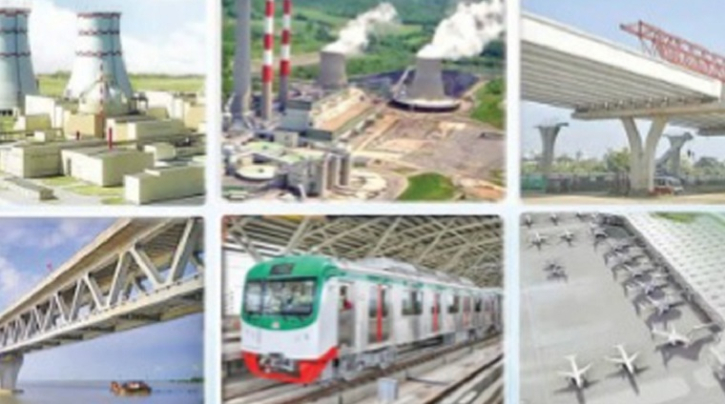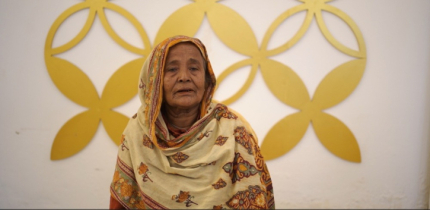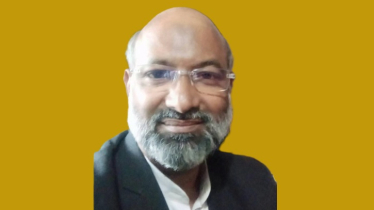
Photo: Collected
In the vibrant tapestry of Bangladesh's development narrative, mega projects stand as towering symbols of progress, echoing the visionary dream of its founding leader, Sheikh Mujibur Rahman. The ambitious initiatives undertaken by the nation transcend mere infrastructure development; they embody a collective aspiration for economic prosperity, enhanced connectivity, and sustainable growth. As Bangladesh marches forward, the legacy of Sheikh Mujibur Rahman, affectionately known as Bongo Bondhu, serves as an enduring guidepost, shaping the dreams that have manifested into transformative mega projects.
Bangladesh, a developing country in South Asia, has made remarkable progress in recent years in the implementation of mega projects. These large-scale infrastructure projects have been essential in driving economic growth and improving living standards for the population. Under the ruling government's leadership, Bangladesh has witnessed tremendous achievements in the execution of these ambitious projects.
Bangladesh has embarked on a transformative journey with ambitious mega projects, reflecting the visionary dream of its founding leader, Sheikh Mujibur Rahman, affectionately known as Bongo Bondhu. These projects, spanning infrastructure, energy, and development, aim to propel the nation towards prosperity and self-sufficiency.
.
Some of the remarkable mega projects in Bangladesh are :
1. Padma Bridge: A critical infrastructure project spanning the Padma River, aimed at improving transportation and connectivity.
2. Rooppur Nuclear Power Plant: A significant initiative to meet the country's growing energy demands through nuclear power generation.
3. Chattogram-Cox's Bazar Rail Line: A railway project intended to enhance transportation and boost economic activities in the southeastern region.
4. Matarbari Ultra Super Critical Coal-Fired Power Project: Focused on increasing power generation capacity to address energy needs.
5. Dhaka Metro Rail: A mass rapid transit system for the capital city, Dhaka, to alleviate traffic congestion and improve public transportation.
6. Rampal Power Station: A coal-based power plant aimed at contributing to the country's energy requirements.
7. Payra Deep-sea Port: A deep-sea port project to enhance maritime trade and connectivity.
8. Bangabandhu Satellite-1: The country's first communications satellite, promoting information technology and communication services.
One notable mega project is the Padma Bridge, a symbol of national pride and connectivity. This ambitious undertaking seeks to link the country's southwestern region, fostering economic growth and enhancing transportation networks. The bridge exemplifies Bongo Bondhu's dream of a united and prosperous Bangladesh.
Energy security is another focus, with the Rooppur Nuclear Power Plant being a flagship project. As Bangladesh aspires to meet its growing energy demands sustainably, this initiative aligns with Bongo Bondhu's vision of ensuring a secure and vibrant future for the nation.
The Chattogram-Cox's Bazar Rail Line is another testament to the commitment to infrastructure development. This railway project aims to facilitate trade and transportation, fostering economic activities in the southeastern part of the country, aligning with the vision of a developed and interconnected Bangladesh.
Moreover, the dream of Bongo Bondhu extends to social welfare projects like the 'Vision 2021' initiative, which aims to eradicate poverty, ensure healthcare access, and provide education for all. These endeavors echo the founder's belief in inclusive development and a society where every citizen can prosper.
While Bongo Bondhu's dream and transformative mega projects in Bangladesh aim for progress, challenges and negative impacts persist. Environmental concerns may arise, such as habitat disruption from large-scale infrastructure projects, potentially affecting biodiversity and ecosystem balance.
Economic disparities can emerge if the benefits of these projects are not distributed equitably, leading to social unrest and dissatisfaction among certain segments of the population. Additionally, the financing of mega projects might strain the national budget, diverting resources from essential social services like healthcare and education.
In some cases, mega projects may face delays, cost overruns, or technical challenges, hindering their intended impact and potentially causing frustration among the public. Moreover, improper planning and execution could lead to corruption, undermining the integrity of these initiatives and eroding public trust.
It's crucial to address these potential negative impacts systematically to ensure that Bongo Bondhu's dream translates into sustainable development, benefiting all segments of the population while minimizing adverse effects.
Bangladesh's mega projects epitomize the dream of Bongo Bondhu, fostering economic growth, enhancing connectivity, and ensuring a better quality of life for its citizens. As these projects unfold, they contribute to the realization of a vision that transcends time, leaving a lasting legacy for generations to come.
One of the primary objectives of the Bangladeshi government has been to enhance transportation and communication networks, and they have succeeded in this regard. Several mega projects have been undertaken to improve the connectivity of different parts of the country. The Bangabandhu Bridge, the country's longest bridge, has significantly reduced travel time and facilitated the movement of goods and people between the eastern and western regions. Similarly, the Padma Bridge, one of the largest infrastructure ventures in the country's history, is set to be completed soon, providing a crucial link between the capital city of Dhaka and the southwestern region of the country. These projects have not only improved transportation but have also fostered economic growth, facilitated trade, and created job opportunities. They have opened up new markets and attracted investments, contributing to the overall development of the nation.
In addition to transportation-related mega projects, the Bangladeshi government has also focused on energy and power infrastructure. The construction of various power plants, such as the Rampal Power Plant and the Matarbari Power Project, has helped address the country's energy crisis and ensure a stable power supply. These projects have increased the production capacity of electricity, reducing the dependency on fossil fuels and promoting the use of renewable energy sources. As a result, Bangladesh has witnessed a significant improvement in the availability of electricity, benefiting industries, businesses, and households alike.
Moreover, the government has prioritized education and healthcare in their mega project initiatives. For example, the establishment of the Bangabandhu Sheikh Mujib Medical University, the Sheikh Hasina National Institute of Burn and Plastic Surgery, and numerous medical colleges and hospitals across the country have strengthened the healthcare infrastructure.
.
The income and losses associated with mega projects in Bangladesh can vary based on factors such as project type, execution efficiency, and economic conditions.
Successfully executed mega projects can contribute significantly to economic growth by creating jobs, boosting productivity, and attracting foreign investment. Improved infrastructure can stimulate various sectors, leading to increased tax revenues for the government.
Infrastructure projects, like ports and transportation networks, can enhance trade capabilities, potentially increasing export and import volumes. Mega projects in Bangladesh can exert pressure on foreign currency reserves due to their substantial financing requirements. These projects often involve significant capital investments, and if a substantial portion of the funding comes from foreign sources, it can impact the country's balance of payments and foreign exchange reserves.
Bangladesh may resort to external borrowing to finance mega projects. Repaying these loans, including interest, can create a demand for foreign currency. Mega projects often require the import of machinery, technology, and expertise, which can contribute to a trade imbalance and increase the demand for foreign currency. Volatility in exchange rates can affect the cost of imported materials and services, potentially impacting the overall project cost and the country's foreign currency position. A diverse range of funding sources, including concessional loans, domestic financing, and public-private partnerships, can help distribute the financial burden and mitigate pressure on foreign currency reserves.
Efficient project management, which includes controlling costs, minimizing delays, and ensuring optimal resource allocation, can contribute to mitigating financial pressures associated with mega projects. Enhancing exports and diversifying the export base can generate additional foreign exchange earnings, helping to offset the currency pressure resulting from mega projects.
Balancing the benefits of mega projects with their impact on foreign currency reserves requires prudent financial planning, strategic decision-making, and continuous monitoring to ensure sustainable economic development.
Mega projects may face cost overruns, straining the national budget and potentially leading to financial challenges. Some projects may have adverse environmental impacts, incurring long-term ecological and social costs.
Social Displacement:
Resettlement and displacement of communities for large-scale projects can result in social upheaval and may not always be adequately compensated or managed.
It's important for effective project management, transparency, and governance to mitigate potential losses and ensure that the benefits of mega projects in Bangladesh outweigh any drawbacks. Continuous monitoring, evaluation, and adaptation of strategies are crucial to minimizing risks and maximizing positive outcomes.
Mega projects in Bangladesh have garnered attention and perspectives from foreign countries. Some view these initiatives positively, seeing them as opportunities for economic growth and investment in the region. Foreign investors may be drawn to the potential benefits of improved infrastructure, enhanced connectivity, and expanded trade opportunities.
On the other hand, there could be concerns raised by foreign countries about environmental sustainability, human rights issues, or the geopolitical implications of certain projects. International stakeholders may closely monitor the execution and impact of mega projects to ensure transparency, accountability, and adherence to global standards.
Overall, Bangladesh's mega projects are likely to be observed by foreign nations with a mix of interest and scrutiny, reflecting the broader dynamics of global economic and geopolitical considerations. Successful implementation and positive outcomes may attract further international collaboration, while challenges may prompt diplomatic discussions and calls for responsible and sustainable development practices.
In the wake of steel, concrete, and ingenuity, the mega projects in Bangladesh not only redefine the nation's landscape but also breathe life into the dream of Sheikh Mujibur Rahman. These endeavors, spanning bridges, power plants, and transportation networks, are the tangible manifestations of a visionary leader's aspirations for his people. As the projects unfold and the nation progresses, the dream of Bongo Bondhu lives on, etched into the fabric of Bangladesh's journey towards a future where prosperity, unity, and sustainable development reign supreme. The legacy endures, and the mega projects stand as testaments to the unwavering spirit of a nation chasing dreams forged by its visionary leader.
.
Author : Researcher,Writer and Columist

.png)







